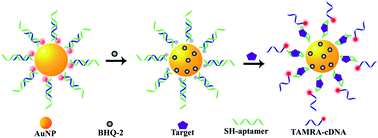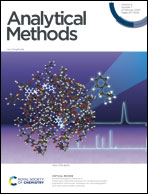FRET-enhanced nanoflares for sensitive and rapid detection of ampicillin†
Abstract
The development of an accurate and simple detection system for antibiotics is of paramount importance for food safety and human health due to their abuse in clinical practice and animal husbandry. In this work, we have constructed novel enhanced nanoflares by incorporating another organic quencher BHQ-2 into the conventional spherical nucleic acid nanoconstruct. The fluorescence of the donor TAMRA was quenched simultaneously by AuNPs and BHQ-2 due to fluorescence resonance energy transfer (FRET). Compared to traditional nanoflares, the one-donor-two-acceptor strategy enhanced the energy transfer efficiency and increased the detection sensitivity for ampicillin (AMP) owing to a reduced background signal. In the presence of AMP, the specific binding of aptamers on the enhanced nanoflares to the target triggered fluorescence recovery in a concentration-dependent manner. With this approach, a detection limit of 0.65 ng mL−1 and a linear dynamic range of 1.8–20 ng mL−1 were achieved for AMP. Moreover, this method also displayed high specificity, good reproducibility, and acceptable accuracy for detection of AMP in spiked milk samples and pharmaceutical products. The principle of the present nanoflares can be extended to other antibiotics for which aptamers are available, providing new insights into the fabrication of nanoscale energy transfer-based aptasensors for antibiotic analysis.



 Please wait while we load your content...
Please wait while we load your content...